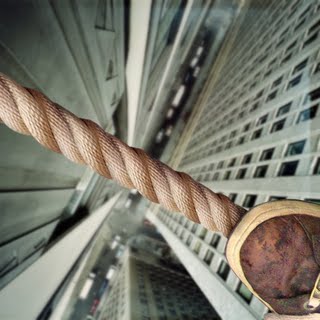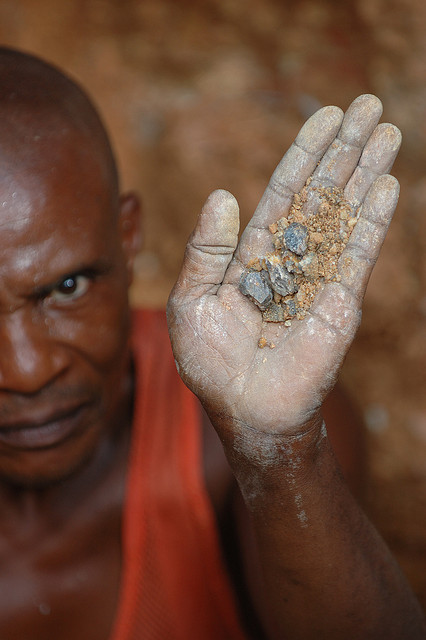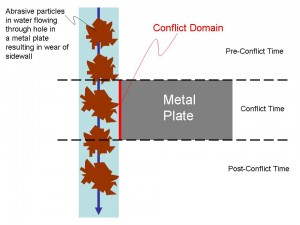Archive for the ‘TRIZ’ Category
Don’t boost innovation, burst it.
 The most difficult part of innovation is starting, and the best way to start is the Innovation Burst Event, or IBE. The IBE is a short, focused event with three objectives: to learn innovation methods, to provide hands-on experience, and to generate actual results. In short, the IBE is a great way to get started.
The most difficult part of innovation is starting, and the best way to start is the Innovation Burst Event, or IBE. The IBE is a short, focused event with three objectives: to learn innovation methods, to provide hands-on experience, and to generate actual results. In short, the IBE is a great way to get started.
There are a couple flavors of IBEs, but the most common is a single day even where a small, diverse group gets together to investigate some bounded design space and to create novel concepts. At the start, a respected company leader explains to the working group the importance of the day’s work, how it fits with company objectives, and sets expectations there will be a report out at the end of the day to review the results. During the event, the working group is given several design challenges, and using innovation tools/methods, creates new concepts and builds “thinking prototypes.” The IBE ends with a report out to company leaders, where the working group identifies patentable concepts and concepts worthy of follow-on work. Company leaders listen to the group’s recommendations and shape the go-forward actions.
The key to success is preparation. To prepare, interesting design space is identified using multiple inputs: company growth objectives, new market development, the state of the technology, competitive landscape and important projects that could benefit from new technology. And once the design space is identified, the right working group is selected. It’s best to keep the group small yet diverse, with several important business functions represented. In order to change the thinking, the IBE is held at location different than where the day-to-day work is done – at an off-site location. And good food is provided to help the working group feel the IBE is a bit special.
The most difficult and most important part of preparation is choosing the right design space. Since the selection process starts with your business objectives, the design space will be in line with company priorities, but it requires dialing in. The first step is to define the operational mechanism for the growth objective. Do you want a new product or process? A new market or business model? The next step is to choose if you want to radically improve what you have (discontinuous improvement) or obsolete your best work (disruption). Next, the current state is defined (knowing the starting point is more important than the destination) – Is the technology mature? What is the completion up to? What is the economy like in the region of interest? Then, with all that information, several important lines of evolution are chosen. From there, design challenges are created to exercise the design space. Now it’s time for the IBE.
The foundation of the IBE is the build-to-think approach and its building blocks are the design challenges. The working group is given a short presentation on an innovation tool, and then they immediately use the tool on a design challenge. The group is given a short description of the design challenge (which is specifically constructed to force the group from familiar thinking), and the group is given an unreasonably short time, maybe 15-20 minutes, to create solutions and build thinking prototypes. (The severe time limit is one of the methods to generate bursts of creativity.) The thinking prototype can be a story board, or a crude representation constructed with materials on hand – e.g., masking tape, paper, cardboard. The group then describes the idea behind the prototype and the problem it solves. A mobile phone is used to capture the thinking and the video is used at the report out session. The process is repeated one or two times, based on time constraints and nature of the design challenges.
About an hour before the report out, the working group organizes and rationalizes the new concepts and ranks them against impact and effort. They then recommend one or two concepts worthy of follow on work and pull together high level thoughts on next steps. And, they choose one or two concept that may be patentable. The selected concepts, the group’s recommendations, and their high level plans are presented at the report out.
At the report out, company leaders listen to the working group’s thoughts and give feedback. Their response to the group’s work is crucial. With right speech, the report out is an effective mechanism for leaders to create a healthy innovation culture. When new behaviors and new thinking are praised, the culture of innovation moves toward the praise. In that way, the desired culture can be built IBE by IBE and new behaviors become everyday behaviors.
Innovation is a lot more than Innovation Burst Events, but they’re certainly a central element. After the report out, the IBE’s output (novel concepts) must be funneled into follow on projects which must be planned, staffed, and executed. And then, as the new concepts converge on commercialization, and the intellectual comes on line, the focus of the work migrates to the factory and the sales force.
The IBE is designed to break through the three most common innovation blockers – no time to do innovation; lack of knowledge of how do innovation (though that one’s often unsaid); and pie-in-the-sky, brainstorming innovation is a waste of time. To address the time issue, the IBE is short – just one day. To address the knowledge gap, the training is part of the event. And to address the pie-in-the-sky – at the end of the day there is tangible output, and that output is directly in line with the company’s growth objectives.
It’s emotionally challenging to do work that destroys your business model and obsoletes your best products, but that’s how it is with innovation. But for motivation, think about this – if your business model is going away, it’s best if you make it go away, rather than your competition. But your competition does end up changing the game and taking your business, I know how they’ll do it – with Innovation Burst Events.
Image credit – Pascal Bovet
Customer Value – the Crowned Jewel of Innovation
Innovation results in things that are novel, useful, and successful. These things can be products, services, data, information, or business models, but regardless of the flavor, they’re all different from what’s been done before.
And when things are different, they’re new; and that means we don’t know how to do them. We don’t know how to start; don’t know how to measure; don’t know how they’ll be received; don’t know if they’ll be successful.
In the commercial domain, successful means customers buy your products and pay for your services. When customers value your new stuff more than they value their money, they pay; and when they pay it’s success. But first things first – before there can be success, before there can be innovation, there must be customer value. With innovation, customer value is front and center.
How do you come up with ideas that may have customer value? There’s a goldmine of ideas out there, with some veins better than others, and any dowsing you can use to pan the high grade ore is time well spent. There are two tools of choice: one that channels the voice of the customer and a second that channels the voice of the technology.
Your technology has evolved over time and has developed a trajectory which you can track. (Innovation On Demand, Fey and Riven.) But at the highest level, as a stand-in for technology, it’s best to track the trajectory of your products – how they’ve improved over time. You can evaluate how your products improved over multiple lines of evolution, and each line will help you to channel the future from a different perspective.
The voice of your customers is the second divining rod of choice. What they say about you, your company, and your products can help you glean what could be. But this isn’t the same as VOC. This is direct, unfiltered, continuous real time capture of self-signified micro stories. This is VOC without the soothsaying, this is direct connection with the customer. (Sensemaker.)
There are two nuggets to pan for: limiting cant’s and purposeful misuse. You seek out groups of customer stories where customers complain about things your product cannot do and how those cant’s limit them. These limiting cant’s are ripe for innovation since your customers already want them. Purposeful misuse is when the radical fringe of your customer base purposely uses your product in a way that’s different than you hoped. These customers have already looked into the future for you.
Do these ideas have customer value? The next step is to evaluate the value of your diamonds in the rough. The main point here is only customers can tell you if you’ve hit the mother lode. But, since your ideas are different than anything they’ve experienced, in order assay the ideas you’ve got to show them. You’ve got to make minimum viable prototypes and let them use their loop to judge the potential cut, color, clarity, and carat. As a prospector, it’s best to evaluate multiple raw gemstones in parallel, and whatever customers say, even if you disagree, the learning is better than gold.
How can we deliver on the customer value? With your innovations in the rough – ideas you know have customer value – it’s time to figure out what it will take to convert your pyrite prototypes into 24 carat products. There are missing elements to be identified and fundamental constraints to be overcome and backplane of the transmutation is problem definition. Done right, the technology development work is a series of well-defined problems with clear definitions of success. From the cleaving, blocking and cutting of technology development the work moves to the polishing of product development and commercialization.
Innovation can’t be fully defined with a three question framework. But, as long as customer value is the crowned jewel of your innovation work, most everything else will fall into place.
Circle of Life
Engineers solve technical problems so
Other engineers can create products so
Companies can manufacture them so
They can sell them for a profit and
Use the wealth to pay workers so
Workers can support their families and pay taxes so
Their countries have wealth for good schools to
Grow the next generation of engineers to
Solve the next generation of technical problems so…
Beyond Dead Reckoning
 We’re afraid of technology development because it’s risky. And figuring out where to go is the risky part. To figure out where to go companies use several strategies: advance multiple technologies in parallel; ask the customer; or leave it to company leader’s edict. Each comes with its strengths and weaknesses.
We’re afraid of technology development because it’s risky. And figuring out where to go is the risky part. To figure out where to go companies use several strategies: advance multiple technologies in parallel; ask the customer; or leave it to company leader’s edict. Each comes with its strengths and weaknesses.
I think the best way to figure out where to go is to figure out where you are. And the best way to do that is data-driven S-curve analysis.
To collect data, look to your most recent product launches, say five, and characterize them using a goodness-to-cost ratio. (Think miles per gallon for your technology.) Then plot them chronologically and see how the goodness ratio has evolved – flat, slow growth, steep growth, or decline. The shape of the curve positions your technology within the stages of the S-curve and its location triangulated with contextual clues. You know where you are so you can figure out where to go.
Here’s what the stages feel like and what to do when you’re in them:
Stage 1: Infancy – New physics are used to deliver a known function, but it’s not ready for commercialization. This is like early days of the gasoline-electric hybrid vehicles, where the physics of internal combustion was combined with the physics of batteries. In Stage 1 the elements of the overall system are established, like when Honda developed its first generation Honda Insight and GM its EV1. Prototypes are under test, and they work okay, but not great. In Stage 1, goodness-to-cost is lower than existing technologies (and holding), but the bet is when they mature goodness-to-cost will be best on the planet.
If your previous products were Stage 4 (Maturity) or Stage 5 (Decline), your new project should be in Stage 1. If your existing project is in Stage 1, focus on commercialization. If all your previous projects were (are) in Stage 1, you should focus on commercializing one (moving to Stage 2) at the expense of starting a new one.
Stage 2: Transitional – A product is launched in the market and there is intense competition with existing technologies. In Stage 2, several versions of new technology are introduced (Prius, Prius pluggable, GM’s Volt, Nissan Leaf), and they fight it out. Goodness-to-cost is still less than existing technologies, but there’s some element of the technology that’s attractive. For electric vehicles, think emissions.
If your previous products were Stage 4 (Maturity) or Stage 5 (Decline) and your current project just transitioned from Stage 1, you’re in the right place. In Stage 2, fill gaps in functionality; increase controllability – better controls to improve battery performance; and develop support infrastructure -electric fueling stations.
Stage 3: Growth – Goodness-to-cost increases rapidly, and so do sales. (I think most important for an electric vehicle is miles per charge.)
If you’re in Stage 3, it’s time to find new applications – e.g., electric motorcycles, or shorten energy flow paths – small electric motors at the wheels.
Stage 4: Maturity – The product hits physical limits – flat miles per gallon; hits limits in resources – fossil fuels; hits economic limits – costly carbon fiber body panels to reduce weight; or there’s rapid growth in harmful factors – air pollution.
If you’re in Stage 4, in the short term add auxiliary functions – entertainment systems, mobile hotspot, heated steering wheel, heated washer fluid; or improve aesthetics – like the rise of the good looking small coupe. In the long term, start a Stage 1 project to move to new physics – hydrogen fuel cells.
Stage 5: Decline – New and more effective systems have entered their growth stage – Nissan Leaf outsells Ford pickup trucks.
If you’re in Stage 5, long ago you should have started at Stage 1 project – new physics. If you haven’t, it may be too late.
S-curve analysis guides, but doesn’t provide all the answers. That said, it’s far more powerful than rock-paper-scissors.
(This thinking was blatantly stolen from Victor Fey’s training on Advanced S-Curve Analysis. Thank you, Victor.)
The human side of Technology
 Technology has strong character traits; it has wants and desires; it plans for the future. It’s alive.
Technology has strong character traits; it has wants and desires; it plans for the future. It’s alive.
Technology continually tries to reinvent itself. And like rust, it never sleeps – it continually thinks, schemes, and plans how to do more with less (or less with far less). That’s Technology’s life dream, its prime directive – more with less. All day, every day it strives, reaches, and writhes toward more with less.
Technology needs our help along its journey. To do this we must understand its life experiences, understand its emotional state, and listen when it talks of the future. Like with a good friend, listening is important.
Technology has several important character traits which govern how it goes about its life’s work. Habitually, it likes to focus its energy on one a single subsystem and reinvents it, where the reinvented subsystem then puts strain on the others. It is this mismatch in capability among the subsystems that Technology uses to fuel innovation on the next subsystem. Its work day goes like this: innovate on a subsystem, create strife among the others, and repeat.
Technology likes to continually increase its flexibility. It feels better when it can stretch, bend, twist, and contort. It likes to develop pivot points, hinges, and rubbery algorithms that adjust to unexpected inputs and create novel outputs. Ultimately Technology wants to self-design and self-configure, but that’s down the road.
Technology likes to get into the details – the deeper the better. To do this it gets small. Here’s its rationale: small changes at the molecular or atomic levels roll up to big changes at the system level. A small change multiplied by Avogadro’s number makes for a big lever. Technology understands this.
Technology is frugal, not wasteful in any way, especially when it comes to energy. Its best party trick is to shorten energy flow paths. The logic: shorter energy paths result in less loss and a simpler product. You’ll see this in its next round of work in energy efficiency where it will move subsystems closer to each other to radically improve efficiency and radically reduce product complexity.
Technology knows where it wants to go, and has its favorite ways to get there. Our innovation engines will be more productive if they’re informed by its character.
(Special thanks to Victor Fey for teaching me about Technology’s character traits, which he calls lines of evolution.)
Blind To Your Own Assumptions
 Whether inventing new technologies, designing new products, or solving manufacturing problems, it’s important to understand assumptions. Assumptions shape the technical approach and focus thinking on what is considered (assumed) most important. Blindness to assumptions is all around us and is a real reason for concern. And the kicker, the most dangerous ones are also the most difficult to see – your own assumptions. What techniques or processes can we use to ferret out our own implicit assumptions?
Whether inventing new technologies, designing new products, or solving manufacturing problems, it’s important to understand assumptions. Assumptions shape the technical approach and focus thinking on what is considered (assumed) most important. Blindness to assumptions is all around us and is a real reason for concern. And the kicker, the most dangerous ones are also the most difficult to see – your own assumptions. What techniques or processes can we use to ferret out our own implicit assumptions?
By definition, implicit assumptions are made without formalization, they’re not explicit. Unknowingly, fertile design space can be walled off. Like the archeologist digging on the wrong side of they pyramid, dig all he wants, he won’t find the treasure because it isn’t there. Also with implicit assumptions, precious time and energy can be wasted solving the wrong problem. Like the auto mechanic who replaced the wrong part, the real problem remains. Both scenarios can create severe consequences for a product development project. (NOTE: the notion of implicit assumptions is closely related to the notion of intellectual inertia. See Categories – Intellectual Inertia for a detailed treatment.)
Now the tough part. How to identify your own implicit assumptions? When at their best, the halves of our brains play nicely together, but never does either side rise to the level of omnipotence. It’s impossible to stand outside ourselves and watch us make implicit assumptions. We don’t work that way. We need some techniques.
Narrow, narrow, narrow. The probability of making implicit assumptions decreases when the conflict domain is narrowed.
Narrow in space and time to make the conflict domain small and assumptions are reduced.
Narrow the conflict domain in space – narrow to two elements of the design that aren’t getting along. Not three elements – that’s one too many, but two. Narrow further and make sure the two conflicting elements are in direct physical contact, with nothing in between. Narrow further and define where they touch. Get small, really small, so small the direct contact is all you see. Narrowing in space reduces space-based assumptions.
Narrow the conflict domain in time – break it into three time domains: pre-conflict time, conflict time, post-conflict time. This is a foreign idea, but a powerful one. Solutions are different in the three time domains. The conflict can be prevented before it happens in the pre-conflict time, conflict can be dealt with while it’s happening (usually a short time) in the conflict time, and ramifications of the conflict can be cleaned up in the post-conflict time. Narrowing in time reduces time-based assumptions.
Assumptions narrow even further when the conflict domain is narrowed in time and space together, limiting them to the where and when of the conflict. Like the intersection of two overlapping circles, the conflict domain is sharply narrowed at the intersection of space and time – a small space over a short time.
It’s best to create a picture of the conflict domain to understand it in space and time. Below (click to enlarge) is an example where abrasives (brown) in a stream of water (light blue) flow through a hole in a metal plate (gray) creating wear of the sidewall (in red). Pre-conflict time is before the abrasive particles enter the hole from the top; conflict time is while the particles contact the sidewall (conflict domain in red); post-conflict time is after the particles leave the hole. Only the right side of the metal place is shown to focus on the conflict domain. There is no conflict where the abrasive particles do not touch the sidewall.
Even if your radar is up and running, assumptions are tough to see – they’re translucent at best. But the techniques can help, though they’re difficult and uncomfortable, especially at first. But that’s the point. The techniques force you to argue with yourself over what you know and what you think you know. For a good start, try identify the two elements of the design that are not getting along, and make sure they’re in direct physical contact. If you’re looking for more of a challenge, try to draw a picture of the conflict domain. Your assumptions don’t stand a chance.
Tools for innovation and breaking intellectual inertia
 Everyone wants growth – but how? We know innovation is a key to growth, but how do we do it? Be creative, break the rules, think out of the box, think real hard, innovate. Those words don’t help me. What do I do differently after hearing them?
Everyone wants growth – but how? We know innovation is a key to growth, but how do we do it? Be creative, break the rules, think out of the box, think real hard, innovate. Those words don’t help me. What do I do differently after hearing them?
I am a process person, processes help me. Why not use a process to improve innovation? Try this: set up a meeting with your best innovators and use “process” and “innovation” in the same sentence. They’ll laugh you off as someone that doesn’t know the front of a cat from the back. Take your time to regroup after their snide comments and go back to your innovators. This time tell them how manufacturing has greatly improved productivity and quality using formalized processes. List them – lean, Six Sigma, DFSS, and DFMA. I’m sure they’ll recognize some of the letters. Now tell them you think a formalized process can improve innovation productivity and quality. After the vapor lock and brain cramp subsides, tell them there is a proven process for improved innovation.
A process for innovation? Is this guy for real? Innovation cannot be taught or represented by a process. Innovation requires individuality of thinking. It’s a given right of innovators to approach it as they wish, kind of like freedom of speech where any encroachment on freedom is a slippery slope to censorship and stifled thinking. A process restricts, it standardizes, it squeezes out creativity and reduces individual self worth. People are either born with the capability to innovate, or they are not. While I agree that some are better than others at creating new ideas, innovation does not have to be governed by hunch, experience and trial and error. Innovation does not have to be like buying lottery tickets. I have personal experience using a good process to help stack the odds in my favor and help me do better innovation. One important function of the innovation process is to break intellectual inertia.
Intellectual inertia must be overcome if real, meaningful innovation is to come about. When intellectual inertia reigns, yesterday’s thinking carries the day. Yesterday’s thinking has the momentum of a steam train puffing and bellowing down the tracks. This old train of thought can only follow a single path – the worn tracks of yesteryear, and few things are powerful enough to derail it. To misquote Einstein:
The thinking that got us into this mess is not the thinking that gets us out of it.
The notion of intellectual inertia is the opposite of Einstein’s thinking. The intellectual inertia mantra: the thinking that worked before is the thinking that will work again. But how to break the inertia? Read the rest of this entry »
Reducing the risk of Innovation
 Though we can’t describe it in words, or tell someone how to do it, we all know innovation is good. Why is it good? Look at the causal chain of actions that create a good economy, and you’ll find innovation is the first link.
Though we can’t describe it in words, or tell someone how to do it, we all know innovation is good. Why is it good? Look at the causal chain of actions that create a good economy, and you’ll find innovation is the first link.
When innovation happens, a new product is created that does something that no other product has done before. It provides a new function, it has a new attribute that is pleasing to the eye, it makes a customer more money, or it simply makes a customer happy. It does not matter which itch it scratches, the important part is the customer finds it valuable, and is willing to pay hard currency for it. Innovation does something amazing, it results in a product that creates value; it creates something that’s worth more than the sum of its parts. Starting with things dug from the ground or picked from it – dirt (steel, aluminum, titanium), rocks (minerals/cement/ceramics), and sticks (wood, cotton, wool), and adding new thinking, a product is created, a product that customers pay money for, money that is greater than the cost of the dirt, rocks, sticks, and new thinking. This, my friends, is value creation, and this is what makes national economies grow sustainably. Here’s how it goes.
Customers value the new product highly, so much so that they buy boatloads of them. The company makes money, so much so stock price quadruples. With its newly-stuffed war chest, the company invests with confidence, doing more innovation, selling more products, and making more money. An important magazine writes about the company’s success, which causes more companies to innovate, sell, and invest. Before you know it, the economy is flooded with money, and we’re off to the races in a sustainable way – a way based on creating value. I know this sounds too simplistic. We’ve listened too long to the economists and their theories – spur demand, markets are efficient, and the world economy thing. This crap is worse than it sounds. Things don’t have to be so complicated. I wish economists weren’t so able to confuse themselves. Innovate, sell, and invest, that’s the ticket for me.
Innovation – straightforward, no, easy, no. Innovation is scary as hell because it’s risky as hell. The risk? A company tries to develop a highly innovative product, nothing comes out the innovation tailpipe, and the company has nothing for its investment. (I can never keep the finance stuff straight. Does zero return on a huge investment increase or decrease stock price?) It’s the tricky risk thing that gets in the way of innovation. If innovation was risk free, we’d all be doing it like voting in Chicago – early and often. But it’s not. Although there is a way to shift the risk/reward ratio in our favor.
After doing innovation wrong, learning, and doing it less wrong, I have found one thing that significantly and universally reduces the risk/reward ratio. What is it?
Know you’re working on the right problem.
Work on the right problem? Are you kidding? This is the magic advice? This is the best you’ve got? Yes.
If you think it’s easy to know you’re working on the right problem, you’ve never truly known you were working on the right problem, because this type of knowing is big medicine. Innovation is all about solving a special type of problem, problems caused by fundamental conflicts and contradictions, things that others don’t know exist, don’t know how to describe, or define, let alone know how to eliminate. I’m talking about conflicts and contradictions in the physics sense – where something must be hot and cold at the same time, something must be big while being small, black while white, hard one instant, and soft the next. Solve one of those babies, and you’ve innovated yourself a blockbuster product.
In order to know you’re working on the right problem (conflict or contradiction), the product is analyzed in the physics sense. What’s happening, why, where, when, how? It’s the rule (not the exception) that no one knows what’s really going on, they only think they do. Since the physics are unknown, a hypothesis of the physics behind the conflict/contradiction must be conjured and tested. The hypothesis must be tests analytically or in the lab. All this is done to define the problem, not solve it. To conjure correctly, a radical and seemingly inefficient activity must be undertaken. Engineers must sit at their desk and think about physics. This type of thinking is difficult enough on its own and almost impossible when project managers are screaming at them to get off their butts and fix the problem. As we know, thinking is not considered progress, only activity is.
After conjuring the hypothesis, it’s tested to prove or disprove. If dis-proven, back to the desk for more thinking. If proven, the conflict/contradiction behind the problem is defined, and you know you’re working on the right problem. You have not solved it, you’ve only convinced yourself you’re working on the right one. Now the problem can be solved.
Believe it or not, solving is the easy part. It’s easy because the physics of the problem are now known and have been verified in the lab. We engineers can solve physics problems once they’re defined because we know the rules. If we don’t know the physics rules off the top of our heads, our friends do. And for those tricky times, we can go to the internet and ask Google.
I know all this sounds strange. That’s okay, it is. But it’s also true. Give your engineers the tools, time and training to identify the problems, conflicts, and contradictions and innovation will follow. Remember the engineering paradox, sometimes slower is faster. And what about those tools for innovation? I’ll save them for another time.
Make it worse and do the opposite
It’s time to write, but, again, no topic. This writing-once-a-week thing is tough. I drop my son off at the hockey rink and walk back to the parking lot to write in my car (I’m telling you, this is a good place to write). Before I get to my car, my cell phone rings. It’s a teacher friend of mine. He’s the guy at the high school who helps kids work out issues with substance use/abuse and related topics. He’s a real pro – every high school should have a person of his caliber. Without introducing himself, he says, “You want to go for a hike tomorrow?” “I have to work,” I say. “It’s Veteran’s Day,” he says. “Yeah, I know, and I have to work,” I reply. “Oh ya, I forgot about that,” he says with a chuckle.
My mind clicks and I remember a discussion we had the previous week while on a walk. I ask, “Do you remember talking about that trick to break intellectual inertia?” “Ya, we talked about how I used it to help a kid work himself out of some destructive behavior. Make it worse and do the opposite,” he says. “I love it; it works great,” he says. I now have my topic. We talk for a while and he helps my thinking converge. This one is a joint effort.
Here’s the problem: problems are stressful. We have a physiological reaction to problems; adrenaline rushes through our veins; our blood pressure increases; our heart rate increases; we get flushed. This is real. It’s run or attack, flight or fight. Our mental processing is all about survival. And there is real reason for concern; there are real consequences to not solving a problem – your reputation, your authority, your job. Read the rest of this entry »



 Mike Shipulski
Mike Shipulski